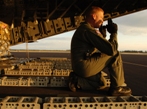 The Israel Air Force has for the past few years been developing a variety of high-tech systems to counter every sort of rocket – from jerrybuilt Qassams to Iranian ballistic missiles. But until now no one knew how they would work together.
The Israel Air Force has for the past few years been developing a variety of high-tech systems to counter every sort of rocket – from jerrybuilt Qassams to Iranian ballistic missiles. But until now no one knew how they would work together.
In order to find out, the air force this week began laboratory tests on all of its anti-missile defense systems, the military said in a statement today.
Named ‘Tiramisu’ after a multi-layered Italian pudding dish, the computer-simulated exercise tested how well several new systems would cope with a simultaneous barrage of missiles at every possible altitude and trajectory.
Israel’s defense forces are in the coming years due to begin operating three anti-missile systems: Iron Dome will tackle rockets with a shorter range of up to 60 kilometers; David’s Sling – known also as Magic Wand – has a range of hundreds of kilometers; while the Arrow 3 is designed to shoot down missiles outside the earth’s atmosphere.
Iron Dome is scheduled to become operational in the next few months. The longer-range systems are still under development.
All three will be operated by anti-aircraft units of the IAF, which has in the last year has been working to coordinate the functioning of its layer-cake air defenses.
“We tested the operability of our systems to handle every threat, from Qassam fire from Gaza to Fajr missiles fired from Lebanon, to the Iranian Shihab,” said Lt. Col. Avi Cohen, who manages the IAF’s Arrow program.
One aim of the exercise was to see how each system would function as a back-up for the others after a failure to shoot down an incoming missile at the first attempt, the military said.
Results of the computer testing will give the IAF a better idea of where best to deploy its anti-missile defenses, as well helping commanders draw up recommendations to the Defense Ministry over how many batteries of each type it should acquire.
Testing should also help the IAF decide on whether to set up a joint operations center for all three programs and the other systems also tested in the exercise: Israeli-built Arrow 2 and Patriot systems; and American Aegis and THAAD-Patriot batteries based permanently in Israel for emergency deployment.
“This is the first time we have run comprehensive tests on all the systems,’ Cohen said, adding that the simulations would give the air force experience of operating the new technology even before it was delivered.
Israeli forces are preparing to face arsenals of thousands of rockets which it believes have been accumulated by Hamas in the Gaza Strip and by Hezbollah in Lebanon, as well as heavy missiles launched from Syria and Iran.
The IDF fears that in any new confrontation it may have to contend with enemy rockets far more accurate than in the past, capable of being targeted not just at large population centers but at individual military sites.
{Haaretz/Yair Alpert-Matzav.com Israel}












This is nothing new. Back in the 1980s I did a study for IAI on Arrow-2/Patriot interoperability.
The Israelis are pretty good at this; so is the US and other countries.
There are bigger issues which limit defensive systems, especially the inner, short range layers. Israel understands this as well, and is dealing with them.
Bottom line: ein lanu al mi lismoch, ela Avinu Shebashamayim.
A freilichen Pesach.
Einstein, I thought you were dead.
Eli, I thought you were dead, too.
I Shmuel 4:18.